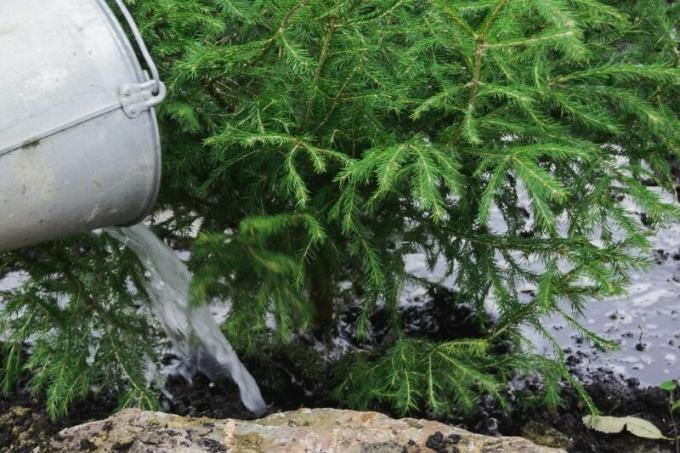
Fir trees are not only popular at Christmas. The evergreen shrubs look decorative all year round. What can be the reason if the fir tree dries up and suddenly loses its needles?
In a nutshell
- Lack of water is the most common trigger for the needles drying up and falling off
- Waterlogging, care errors and pests are also possible causes
- water regularly (especially in hot weather), check soil moisture, ensure good drainage
- Choose a pollution-free location
- natural needle fall in late summer no need to worry
Table of contents
- Brown needles
- lack of water
- waterlogging
- pollutants
- pests
- frequently asked Questions
Brown needles
The green needles make the beauty of the fir out of. When the tree dries up and suddenly loses its needles, an unsightly framework remains. If you know the causes and take countermeasures quickly, you can still save the fir. We have compiled the causes and possible countermeasures for you.
A notice: At some conifers the loss of needles, especially in winter, is a natural process.
lack of water

The traces of the dry, hot summers of recent years are particularly evident on conifers such as firs, Pine trees and yew trees visible. Dryness is the most common cause of browning and needle dropping. Dry soils are additionally compacted so that rainwater runs away instead of seeping into the ground.
This restricts the water and nutrient supply of the tree. The tree dries up. The discoloration of the needles is the first sign.
A notice: Even winters with little precipitation can cause the fir to dry up. The dried out soil endangers the nutrient supply of the conifers.
What helps?
- Check soil moisture penetration
- Loosen the soil around the fir
- pour vigorously
Tip: Use a stick to check for moisture penetration. If it can't be planted about six inches into the ground, the soil is too dry.
Prevent
Mulch the tree discs to keep the moisture in the soil longer. Water early in the morning or late in the evening in summer. Water only on frost-free days in winter.
waterlogging

Not just too little, but also too much water can be the cause of the pine needles turning brown. Waterlogging softens the root and triggers rot. Damage to the roots makes nutrient supply more difficult. Although sufficient water is available, the fir dries up. As a result, the needles turn brown and fall off. Mold can also form on the surface.
A notice: If it smells musty around the fir, rot is the cause.
What helps?
| For small trees | With big trees |
|---|---|
| – Dig up the tree with the roots – Cut off damaged roots – Allow the root ball to air dry for several hours – Fill the planting hole with drainage – Insert tree – Fill the planting hole with fresh, dry substrate - Plant the tree again |
– Remove soil from the root area as deep as possible – Let the roots dry for two to three days – If necessary, support the tree with a stake – Fill the planting hole with a mixture of dry substrate and gravel – Water again after a week at the earliest |
Prevent
When planting a fir, fill in a layer of gravel as drainage in the planting hole.
pollutants

Fir trees are sensitive to pollutants in the air and in the soil. If the trees are in areas where the CO2-load is very high, the needles can turn brown. Road salt or excessive fertilization can also damage the trees.
What helps?
You can still transplant small fir trees. This is no longer possible with large fir trees. Do a soil analysis. If pollutants in the soil can be identified as the cause, remove the soil over a large area. Replace the soil with fresh substrate.
Prevent
Do not plant fir trees along busy roads. Don't fertilize the trees too much, follow the package instructions.
pests

Source: Jerzy Opioła, Dreyfusia nordmannianae a1 (3), Edited from Plantopedia, CC BY-SA 4.0
Pests can also be the cause of yellowing of the needles and needle fall. The most common fir pests include:
| pine aphids (Dreyfusia nordmannianae) |
pine stem lice (Dreyfusia or. Adelges piceae) |
Mealybug (pseudococcidae) |
|---|---|---|
| - Size: 1 to 3 mm – dark colored – Whitish sides and middle of the back |
- very small (max. 0.4mm) – eye-catching orange eggs – black-reddish lice |
– white waxy hairs – woolly coating on branches |
What to do?
- detect pests
- collect larger specimens
- Spray down trees with a powerful jet of water
- Spray affected areas with soapy water
- Use chemical sprays exactly as directed
- predators (ex. B. ladybug, lacewings or parasitic wasps) against mealybugs
frequently asked Questions
No, new needles often form after two to three years. If you use our hints to fight the causes of the needle fall, there is a chance of rescue.
It is possible that there is a natural cause. Coniferous trees shed some of the old needles in late summer. This natural process is comparable to the falling of the leaves deciduous trees. After dry, hot summers, the natural fall of the needles is particularly pronounced.
Coniferous trees also benefit from professional fertilization. A magnesium deficiency is often the trigger for discolouration of the needles and needle fall. Conifer fertilizer is suitable for fertilizing.



